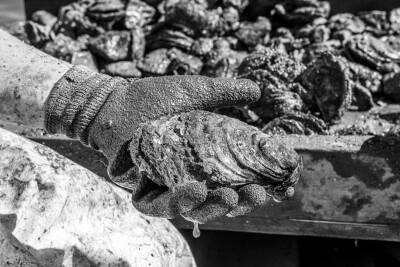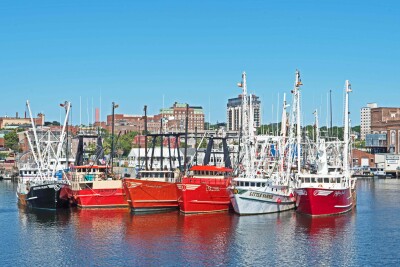Northeast
Wood is good for this Maine yard; lobsterman gets a left-handed boat
In an industry defined by fiberglass and metal boats, Peter Kass at John's Bay Boat Co. in South Bristol, Maine, is building his 65th wooden boat, and most of them have been for commercial fishermen. This one is a 46' x 15' lobster boat for Stonington, Maine's, Ryan Larrabee. It's a stretched-out version of a 44-foot lobster boat Kass launched last July.
The hull is 1 1/4-inch cedar planking over 1 1/2" x 2 1/2" steam-bent oak ribs. The deck is seamed and caulked 1 1/2-inch Douglas fir. That will be topped with a layer of bridge tiles.
Larrabee's boat will have a couple of features relatively new to lobster boats built at John's Bay Boat Co. One is a fiberglass lobster tank behind the house and about in the middle of the deck. On deck the tank is about waist high, but it goes down to the keel. A hand-cranked elevator-like affair brings lobsters to the tank's surface.
This is only the second lobster tank of this type Kass has installed. The tank holds about 1,700 pounds of lobsters. A hydraulically operated pump circulates water through the tank, and an air pump "aerates the water so there are no dead or weak lobsters. You get a livelier lobster coming out of the tank," Kass says. Besides enabling the fisherman to deliver a better quality lobster, having most of the lobster tank below the deck, "keeps the weight down low." Behind it is a secondary tank that will hold 1,000 pounds. It is also aerated.
Instead of Kass' typical raised-panel wooden sliding door for the split wheelhouse, Larrabee is thinking of going with an aluminum door. He feels it will be more watertight than a wooden door. It will be a Dutch door so the bottom can remain closed when hauling traps.
Down below is an 800-hp Caterpillar C18, hooked up to a ZF 325 marine gear with a 2.5:1 reduction, which turns a 36" x 42" prop on a 2 1/2-inch shaft. Kass figures the 46-footer will top out at 22 to 23 knots.
Forward of the engine will be four bunks and a workspace with an aluminum bench and a vise.
To the eastward in Southwest Harbor, Eric Clark of Marine Systems Custom Boats has a 39-foot Stanley in the shop. Clark says the Sandra David out of Bass Harbor is 24 or 25 years old and is having its tongue-and-groove fir platform replaced. Fishermen like the wood platform — instead of fiberglass over plywood — because it's easier on their legs.
With the platform off, the Marine Systems crew reworked the exhaust, replaced hydraulic hoses, and installed new 4x4 pressure-treated deck beams, along with new hatches.
Marine Systems Custom Boats has also had a couple of repower jobs. One was a South Shore 30 that the shop finished off 24 years ago. They replaced a Lugger with 11,000 hours with a 375-hp John Deere.
"The engine wasn't worn out. He just decided to do something different. He should get 20,000 hours out of it," Clark says.
Another repower was a Calvin 34 where a 375-hp John Deere with 5,000 hours was exchanged for a 420-hp Iveco. Clark says, "The owner wanted something a little lighter. He gained a little speed and uses less fuel."
While some fishermen favor a wood platform because it's easier on their body, one Maine fisherman brought his 37-foot MDI Boatworks lobster boat to Clark's shop because he wanted to give the entire right side of his body a break and let the left side finally do some work.
The fisherman was Tom Macvane, who fishes in Casco Bay. "He'd always had a right-handed boat, and we built him a left-handed boat," Clark says.
Macvane told Clark he "was 49 years old, and now I'm going to give that side of my body a rest and haul on the other side."
So the crew at Marine Systems switched the hauling station and all the controls from the boat's starboard to port side. Clark says, "He was always breaking a trap with his right arm and always running controls with his left hand. He said it didn't take him a week and a half getting used to working the other side." — Michael Crowley
West
A 20-year dry spell comes to an end; Washington yard builds two seiners
It's been a long time since Giddings Boat Works built a commercial fishing boat, 20 years, in fact, since the Charleston, Ore., boatyard has done much more than repairs, rebuilds, repowers and sponsoning jobs. But this October, Mike Pettis pulled away from the dock at Giddings Boat Works in the 67' x 25' Patriot and steamed to his home port of Newport, Ore.
But a single boat after two decades wasn't enough for the yard. And so on Dec. 23, Todd Whaley of Brookings, Ore., headed home in his new 72' x 28' Miss Emily, which was named after his daughter.
Both boats came from the Seattle naval architect firm with Jensen in its name. The Patriot is from the drawing board of B.F. Jensen & Associates. That was Ben Jensen who founded the naval architecture and marine engineering firm in 1961 that would become Jensen Maritime Consultants.
Pettis bought the Patriot's design and then had Tullio Celano of Crescere Marine Engineering in Columbia City, Ore., make it wider and deeper. The Patriot has a single 610-hp Cummins QSK19 for power.
Jensen Maritime Consultants designed the Miss Emily for an owner who never built the boat, says Giddings Boat Works' Mike Lee. "Todd Whaley liked the looks of it and had it modified, a little deeper and a little wider at Jensen."
The Miss Emily has a 750-hp Cummins QSK19 in its engine room and a Rice speed nozzle around its four-blade prop. Compared to the Patriot's QSK19 that's a big bump up in power. "That was a decision made in progress, as the boat was being built," Lee says, adding that the speed nozzle was put on at the last minute. "We were lucky they had one." The nozzle enables the increased horsepower to be used more effectively than could be done with an open prop.
Both boats will be crabbing and shrimping, though the Miss Emily might also be tendering.
If there was any doubt that Giddings Boat Works would re-establish itself as a builder of new commercial fishing boats, the Patriot and Miss Emily should dispel that notion.
At the fall 2013 Pacific Marine Expo in Seattle, Howard Moe signed a contract with a fisherman from Cordova, Alaska, to build him a 50' x 18' seiner. That boat and a 58' x 23' seiner, also for a Cordova fisherman, are now being built at Moe's Little Hoquiam Shipyard in Hoquiam, Wash.
Actually, construction of the 58-footer started before July when class and load-line regulations went into effect for boats 50 feet and over. "We had started the hull and then turned the hull over and build a new mold off it, so it's been under construction a long time," Moe says.
The mold Little Hoquiam Shipyard was using came from Ed Beck at Beck Boats in Marysville, Wash. "When he went out of business, he gave me a bunch of his stuff. I have several of his molds," says Moe.
The Beck mold has been used to build three or four 58-footers; the only problem is the mold is 56' x 17'. A lot of cutting and expanding of a hull is required to end up with a 58-footer. "There was so much work to expand, we decided to make a hull and build a new mold from it," Moe explains.
A pair of John Deere 6090 diesels will be in the 58-footer's engine room, while behind it are four fish holds with refrigerated seawater and freezing capability, for a total capacity of 150,000 pounds.
There are accommodations for six bunks up forward and in a small stateroom.
The 50-footer — actually it's 49 feet 10 inches — also has accommodations for six and a John Deere 6135 for power. She should pack 75,000 pounds.
Both seiners have a solid fiberglass hull, while the rest of the boat is built up of layers of cored 5-pound, 1-inch cross-linked PVC. "The bulkheads are made with two layers, and the decks are two layers. It comes out to about 2 1/2 inches thick," says Moe.
Besides building the seiners, the crew at the Little Hoquiam Shipyard also has under construction a 32-foot charter boat for sportfishing and a 101-foot yacht. — Michael Crowley
South
Md. builder goes back to crabbing; Chesapeake Bay craftsmen honored
The recent growth of Maryland's and Virginia's oyster fisheries has prompted the refurbishing of numerous older fishing boats around Chesapeake Bay, and one well-known builder of fiberglass boats decided to split his time between building boats and fishing.
Eugene Evans of Evans Boats in Crisfield, Md., says he's rebuilding one of his 30' x 12' fiberglass hulls for himself. "I'm at an age with my family looking after my boatyard that I can take time to go back into oystering and crabbing."
The Cristina, an Evans 30-footer, was originally built as a high-sided recreational boat. "She was in a bad fire, but I felt the hull was worth saving," says Evans. "She was too high-sided to work from, so we cut the sides down and made the necessary modifications to make her into a commercial fishing boat."
The boatyard is also fiberglassing several older wooden boats. Robert T. Brown Sr., president of the Maryland Waterman's Association, just had Evans wrap the hull, keel, bottom and sides of his wooden boat built in 1969 with fiberglass. Evans displayed Brown's boat at the 40th annual East Coast Commercial Fishermen's & Aquaculture Trade Exposition in Ocean City, Md., on Jan. 17-19.
The late Maylon Green of Deltaville built Brown's boat. "Maylon and his brothers built great work boats," says Evans. "I know because I got him to build me one [in the 1970s], and I worked it hard."
Paul S. Green Sr. of Deltaville taught his sons — Maylon, Bobby and Paul Jr. — to build boats. Their yard was on Broad Creek and their round-stern boats were known throughout the bay region as "Broad Creek round sterns." Green and his sons are deceased, but their boats are still working the waters of Chesapeake Bay and beyond.
Evans is currently fiberglassing the Star Gazer, a 42-foot wooden boat for Johnny Brittingham of Crisfield, Md., and the deadrise Loni Carol for Lonnie Moore of Tangier Island. The Star Gazer will work Maryland's crab and oyster fisheries, and the Loni Carol will haul passengers for the Chesapeake Bay Foundation. Moore is the Chesapeake Bay Foundation fleet senior manager.
Deltaville, Va., boatbuilders Willard Norris and Grover Lee Owens were busy last year collecting accolades for years of dedication to the wooden boatbuilding business.
The two old-time Chesapeake Bay boatbuilders received plaques in June at the 37th annual Norfolk, Va., Harborfest and Workboat Races and again in September at the Poquoson Seafood Festival and Workboat Races.
Owens and Norris are the last traditional boatbuilders left in Deltaville, a community that just a few decades ago was a center of wooden boatbuilding on Chesapeake Bay.
At the races, a Norris 42-footer built in 1974, the Rainbow Chaser, won its class and several of Owens' boats were finalists. "They really let us know how much they appreciated wooden boats," says Norris. "There were fiberglass and wooden deadrises running together, but most of the people were cheering for the wooden boats."
Owens no longer builds boats, as he is battling cancer. Though Norris has had both knees replaced, he is building a 28-foot crab and oyster boat. The hull of the 28' x 8' glass-over-wood boat is complete.
"I turned down more calls for new boats last year than I can remember," says Norris. "Oysters are coming back, and watermen want wooden boats to work in that business. It's a shame. I'm too old to do but so much and most [of the other boatbuilders] are gone."
Since Atlantic Metal Products of Topping, Va., completed a 56' x 16' x 30" aluminum oyster barge for Cowart Seafood Corp. in Lottsburg Va., in July 2011, Atlantic Metal Products has been building other types of equipment for the East Coast oyster fishery.
In the past few months, that includes 130 metal oyster baskets (36 1/4" x 45 7/8" x 42 3/4") for carrying oysters to and from the oyster grounds and for moving large quantities of oysters at the dock. The baskets are made of carbon steel and are hot-dipped, galvanize coated.
The cages went to oyster companies in Virginia, Maryland and New Jersey.
— Larry Chowning






